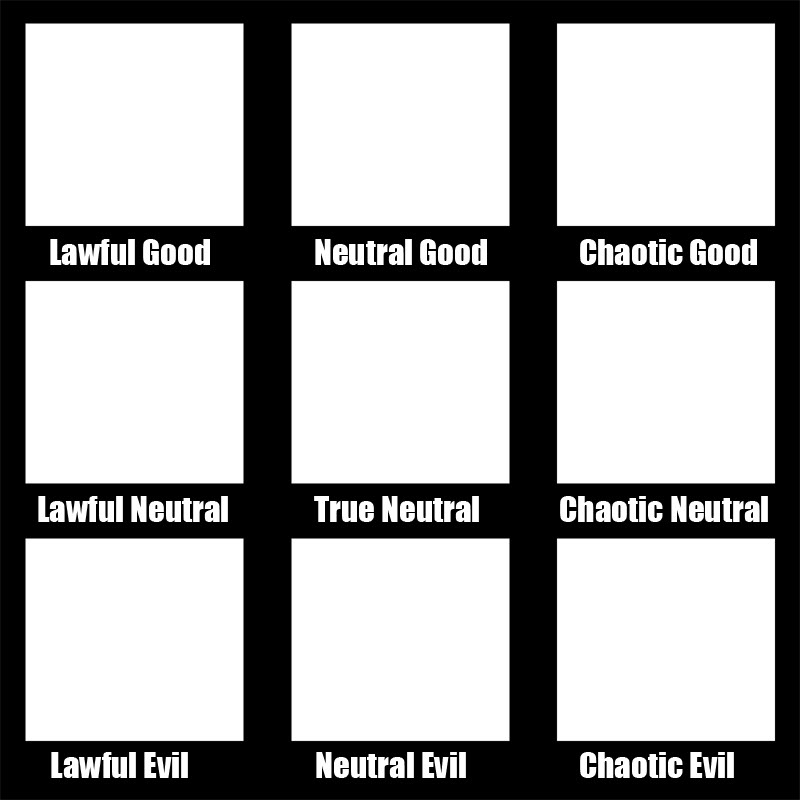
An alignment chart is a tool used to categorize and understand different character types based on their moral and ethical beliefs. It is commonly used in role-playing games, literature, and popular culture to help classify characters and their motives. The chart consists of a grid with two axes, one representing a character’s ethical stance (good, neutral, or evil) and the other representing their moral stance (lawful, neutral, or chaotic).
Each quadrant of the alignment chart represents a different combination of ethical and moral beliefs, resulting in nine possible alignments. These alignments help to define a character’s personality, motivations, and behaviors within a fictional world.
Exploring the Nine Alignments
1. Lawful Good:
Characters who fall into the lawful good alignment are guided by a strong sense of justice and honor. They believe in following the law and upholding moral principles. These characters are typically seen as heroes and champions of justice.
2. Neutral Good:
Neutral good characters value goodness and kindness but may not always follow the law strictly. They prioritize doing what is right and helping others, even if it means bending or breaking the rules in certain situations.
3. Chaotic Good:
Chaotic good characters prioritize personal freedom and individuality. They may have their moral code and are willing to take risks and break the law if they believe it will lead to the greater good.
4. Lawful Neutral:
Lawful neutral characters value order and structure above all else. They believe in following the law and maintaining a stable society, even if it means sacrificing personal freedoms or ethical considerations.
5. True Neutral:
True neutral characters are neutral in both their ethical and moral beliefs. They prioritize balance and harmony and often seek to avoid taking sides in conflicts. They may act in their self-interest or be motivated by a desire for peace.
6. Chaotic Neutral:
Chaotic neutral characters prioritize personal freedom and individuality above all else. They may act on impulse and follow their desires, often disregarding social norms and laws.
7. Lawful Evil:
Lawful evil characters prioritize their interests and power above all else. They believe in following the law, but only if it serves their agenda. They are often manipulative and use the system to their advantage.
8. Neutral Evil:
Neutral evil characters are motivated by their self-interest and will do whatever it takes to achieve their goals. They may not follow the law or adhere to any moral principles, and they are often willing to harm others to get what they want.
9. Chaotic Evil:
Chaotic evil characters are driven by chaos and destruction. They have no regard for the law or moral principles and will do whatever it takes to cause chaos and harm others.
The Significance and Application of Alignment Charts
Alignment charts are not only useful in the context of role-playing games and fictional worlds but they can also be applied to real-life situations. By understanding the different alignments and their characteristics, we can gain insights into human behavior and motivations.
Alignment charts can be used as a framework for understanding the complexities of human personalities and the choices people make. They can help us navigate ethical dilemmas, understand societal dynamics, and even provide a lens through which we can analyze political ideologies.
Additionally, alignment charts can be a valuable tool for character development in storytelling. They provide a starting point for creating well-rounded and believable characters, allowing writers to explore the nuances of their personalities and motivations.
Examples of Alignment Charts




Alignment charts have become popular in various forms of media, and many fandoms have created their charts based on specific franchises or themes. Here are a few examples:
- Star Wars Alignment Chart: This chart categorizes characters from the Star Wars universe based on their alignment, such as Luke Skywalker as lawful good and Darth Vader as lawful evil.
- Harry Potter Alignment Chart: This chart categorizes characters from the Harry Potter series based on their alignment, such as Harry Potter himself as lawful good and Voldemort as chaotic evil.
- Superhero Alignment Chart: This chart categorizes superheroes from various comic book universes based on their alignment, such as Superman as lawful good and Deadpool as chaotic neutral.
- Game of Thrones Alignment Chart: This chart categorizes characters from the Game of Thrones series based on their alignment, such as Jon Snow as lawful good and Cersei Lannister as lawful evil.
These examples demonstrate how alignment charts can be customized to fit specific narratives and provide a deeper understanding of the characters and their actions.
Conclusion
The alignment chart is a valuable tool for understanding and categorizing different character types based on their moral and ethical beliefs. It provides a framework for analyzing human behavior and motivations, both in fictional worlds and real-life situations. By exploring the nine alignments and their characteristics, we can gain insights into the complexities of human personalities and the choices people make. Whether used in role-playing games, storytelling, or as a lens for analyzing society, alignment charts offer a unique perspective on the intricacies of human nature.
Alignment Chart Template – Customize